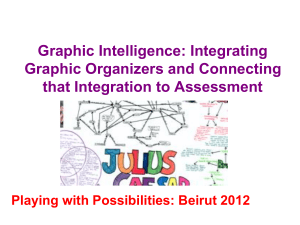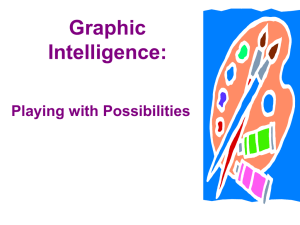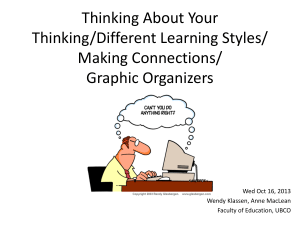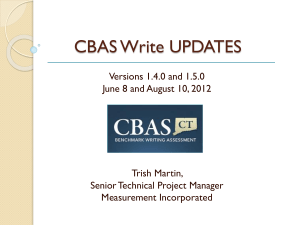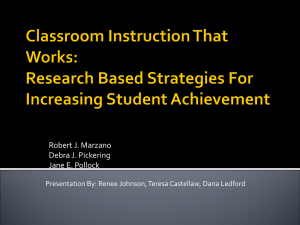Graphic Organizers
advertisement
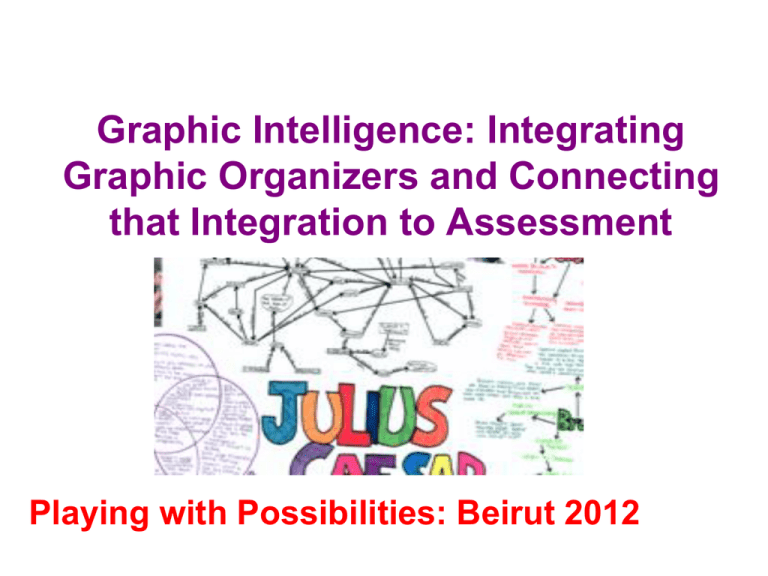
Graphic Intelligence: Integrating Graphic Organizers and Connecting that Integration to Assessment Playing with Possibilities: Beirut 2012 Objective for this session… Extend our understanding of and ability to apply graphic organizers: Ranking Ladders, Venn Diagrams, Fish Bone Diagrams, Mind Mapping and Concept Mapping. And more importantlt, to sense how to integrate multiple graphic organizers and how integration connects to student assessment. Agenda Sequence • • • • Instructional Intelligence Thinking Concept Formation Graphic Organizers Graphic Organizers… – Focus on Mind Maps and Concept Maps – Fish Bone Diagrams – Venn Diagrams – Ranking Ladders Overview of Instructional Intelligence • Instructional intelligence involves: – Knowledge of the learner – Knowledge of curriculum – Knowledge of assessment – Knowledge of instruction – Knowledge of change – Knowledge of systemic change Unconscious Seamless Intentional Conscious CBAM (Concerns Based Adoption Model) • Levels of Use • • • • • • • • Non-User Orientation Preparation Mechanical Routine Refined Integrative Refocusing • Levels of Concern • • • • • • No Concerns Awareness Information Personal Impact on Students Collaborative Skill Training Model Workshop Components Theory (T) Understanding minimal (T) and increases a bit Demonstration (D) (T, D) and solid Practice and introductory Feedback (PF) understanding T, D, PF, and Deeper more Peer Coaching integrative understanding Skill Transfer Acquisition 3% 0% 5-10% 3% 90% 10% > 90% > 90% You need to understand ‘types’ of thinking and ‘levels’ of thinking • Types of Thinking – – – – – – – – Inductive Deductive Ranking Predicting Sequence Inquiry Prioritizing Identify • Levels of Thinking – – – – – • Synthesis Evaluation Analysis Application Comprehension Recall One component of “Knowledge of Instruction” is … Graphic Organizers What do you already know? With a partner, take about two minutes and identify all the graphic organizers you have seen and hopefully experienced. Compare your list with this list and there is no doubt more. Fish Bone, Concept Map, Mind Map, Flow Chart, Time Line, Word Web, Venn Diagram, Ranking Ladder etc. LET’S PLAY WITH ONE Ranking Ladder • identify your top 3 places to visit • rank them from first to last to visit • identify what is missing from your ranking ladder • how do you get students to develop the skills to identify criteria for ranking? RANKING LADDER PMI • What are the PLUSES, MINUSES and IMPORTANT things to consider about Supply Teaching. • How does PMI assist students to more precisely/thoughtfully rank ideas. NOTE: PMI is one of 60 critical thinking tactics from de Bono’s CoRT program. Ranking Graphic Organizers According to their Complexity • Please rank the graphic organizers below using a Ranking Ladder. Fish Bone, Concept Map, Mind Map, Flow Chart, Time Line, Word Web, Venn Diagram, Ranking Ladder RANKING LADDER One Perspective • • • • • • • • Concept Map Mind Map Fish Bone Venn Diagram Ranking Ladder Time Line Flow Chart Word Web What type of thinking and level of thinking do Mind Maps and Concept Maps Invoke? ‘TYPES’ of thinking and ‘LEVELS’ of thinking Types of Thinking Levels of Thinking • Inductive • Synthesis • Deductive • Evaluation • Ranking • Analysis • Predicting • Application • Sequence • Comprehension • Inquiry • Recall • Prioritizing GIVEN • Concept Maps and Mind Maps (if done properly) ask students to first identify what they know and then classify that knowledge into categories -- therefore -- it must be analysis re levels of thinking and inductive thinking regarding types of thinking. So what is the Type and Level of Thinking? • Venn Diagram • Fish Bone Diagram • Ranking Ladder Mind Map/Concept Maps DIRECTIONS: • Put your chairs in circles – say groups of 6 • Analyze Mind Maps or Concept Maps • Identify the critical attributes of MM or CM • Create Venn Diagram • Compare with another table • Share with larger group • Listen to mini-lecture/group discussion Venn Diagram Mind Map Concept Map 2 Dimensional and 3 Dimensional Shapes: What do they have in common? 2 Dimensional 3 Dimensional Venn Diagram Mind Map Start in centre Radiate out Colour Pictures Concept Map Hierarchical Cross Links Start at top Linking words on line Mind Maps and Concept Maps ) Mind Maps ) Concept Maps ) Start in the centre ) ) Radiate out ) hierarchically ) Key words (concepts) ) ) Images ) ) Colour ) ) Cross Links Usually start at the top Radiates down/out hierarchically Key words (concepts) Linking words Cross links with words How are the linking words on the left different from those on the right? has contains includes such as for example may have found in are part of are enhances destroys digests activates needs controls magnifies increases transports reflects breaks down TESTERS transforms made up of Linking Words … how are the blue linking words different from the red? Trees Mirrors Forks Protagonist Muscles Triangles Rocks Bears need reflect and however act like have in the as well as Roots Light Spoons Did Not Levers 3 angles Soil Raccoons Linking Word Testers Blue or Red? plants magnets planets cars poetry verbs explorers friction food require attract including have such as can be are causes on the water most metals the moon engines haiku conjugated courageous heat table Linking Word Testers Blue or Red? plants magnets planets cars poetry verbs explorers friction food require attract including have such as can be are causes on the water most metals the moon engines haiku conjugated courageous heat table Two Types of Linking Words • Descriptive or Passive: they illustrate the students ability to recall and comprehend relationships between two concepts • Cause and Effect or Dynamic: they illustrate the students ability to analyze, synthesize or evaluate relationships between two concepts Assessment • For learning (formative) • Of learning (summative) • Matching our instruction with our assessment • Applying instruction in assessment • Where do graphic organizers fit? a sample provincial outcome • By the end of grade six students will demonstrate their understanding of the four types of motion: oscillating, linear, reciprocating, and rotational. • This has explicit and implicit implications. Explicit Level of Thinking re assessment • This outcome tells kids they will be assessed at the comprehension level of Bloom’s Taxonomy -- they will have to explain each in their own words and be able to generate examples of each type of motion Implicit level at which the teacher will have to teach • This outcome also informs teachers that they will most likely have to teach it at the analysis level of thinking re Bloom’s Taxonomy as the students will have to understand the similarities and differences between the four types of motion. SO… What type of thinking does this outcome encourage? • Inductive thinking -- the students will have to classify the different types of motion -- so, give them some pictures, say 4 or 5 of each, put the pictures in an envelop, have the students work in pairs to classify them -- then do a Jigsaw on each of the four -- then do a Venn Diagram or Fish Bone or Mind Map on the 4 types of motion What instructional methods do you have that push analysis? • • • • • • Venn Diagrams Fish Bone Diagrams Mind Maps Concept Maps Concept Attainment Concept Formation
